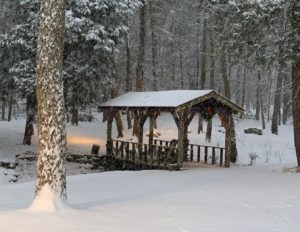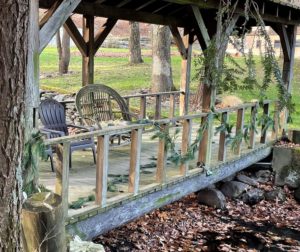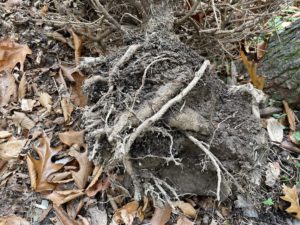Hello fellow readers, There’s a difference between ball and burlap versus potted trees. And sometimes B&B are disguised as container plants, a lesson I learned a sad way. But tending to the outside decorating over the weekend turned the sadness into laughs and happy tears.
Garland cut short.
The garland unfurled to be only twenty feet rather than the customary twenty-five to cover the span of the footbridge over the pond. Kind of like crackers sold in the same size box, but weighing less and costing more, I giggled. Good thing I bought two lengths.
Then came decorating Ellie’s memorial tree, a replacement one. Yes, indeed, sadly, our B&B ‘Baby Blue Eyes’ Spruce which served as last year’s Christmas tree, died. When I sought out the tree, a criterion was container grown. It looked so at the nursery, but it proved to be a B&B put in a pot, not evident until we planted it.
Ball and Burlap versus Potted Tree
Plants grown in the field (called B&B for ball and burlap) versus container trees (grown in a pot) cost about the same. Container plants weigh less as they are grown in lighter materials, yes a convenience, but I prefer them because the roots are intact, lessening the likelihood of transplant shock. B&B’s roots are cut when dug, so the plant must spend energy in root recovery, taking up to a year. Container grown, properly planted, don’t miss a beat. Though it’s true, they tend to dry out more quickly, so be sure you buy from a reputable source and keep the soil moist.
Ellie’s tree was initially diagnosed with Needle Cast (link to story below), killing primarily blue spruces from the bottom up. But when the top wilted in early August, the progression, if indeed a fungal disease, spiraled far faster than I’ve ever seen.
Watching Ellie’s tree die felt incredibly sad. It was about the anniversary of her passing that I accepted it as gone.
A B&B in Disguise.
When we dug it up, the roots were badly cut and crisscrossed with very few new fibrous roots. I felt better that my care was not the cause, instead likely a bad dig. Still, my heart felt heavy.
Then came a mysterious draft email on my phone — a photo of a narrow conical-shaped holly, perhaps an American Holly, taken at a garden center. I sent it to my go-to nurseryman, who confirmed it was an Ilex Opaca. “Looks like the photo was taken here,” Ben said.
“Do you still have it?”
“Yes, I do.”
A sign that it is to be Ellie’s new tree.
American Hollies (Ilex opaca) are native evergreens, A-rated in deer resistance, and thrive in full sun or part-shade zones 5 to 9. They prefer slightly acidic soil but can tolerate clay. The upright, pyramidal beauty makes for a perfect Christmas tree, though your female tree will need a male holly nearby to pollinate. They’ll slowly grow 15 to 30 feet and 10 to 20 feet wide, and birds adore their orange-red berries, as will you.
I smiled when the replacement arrived—the tag, ‘Mary Holman.’ A search to find who the plant is named after proves unfruitful. But I like to think of it as Mary holding Ellie forever in my heart.
Jolee was a cling-on by Curt’s side as he finished the backyard fall cleanup, but she came running to the front as if on cue as I decorated Ellie’s new tree. With wiggly enthusiasm, she greeted me and then quickly sat as if to say, “snag a photo, Mom.” With happy tears in my eyes, I did just that.
Garden Dilemmas? AskMaryStone@gmail.com (and your favorite Podcast App.)
Link to the story about Needle Cast on Ellie’s Memorial Tree
There’s an update to the story in Episode 86 of the Garden Dilemmas Podcast:
Arbor Day Foundations tips on How to Plant Balled and Burlapped Trees and How to Plant Containerized Trees
Link to a previous column about Arbor Day Foundation







